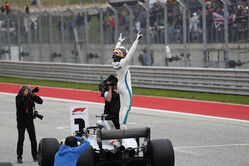


06/10/2019
NEWS STORY
 Check out highlights from any major sport from forty or fifty years ago and it's fair to say that the rules have remained more or less the same.
Check out highlights from any major sport from forty or fifty years ago and it's fair to say that the rules have remained more or less the same.
Not so Formula One. Barely a year passes without the powers-that-be dreaming up some 'improvement' to spice up the show.
Be it technical rule changes that merely drive up costs and make little difference to the pecking order, gimmicks like DRS or tweaks to the format, the changes keep coming, much to everyone's frustration.
Remember the new qualifying format for 2016 which lasted just one race, or how about the double-points in Abu Dhabi in 2014.
Now, in addition to the massive overhaul planned for the technical regulations in 2021, of which a number of teams still have to be convinced, the sport is seeking to tinker with the qualifying format in a bid to (groan) spice up the show and attract new fans.
Though the concept has to be finalised, it is planned that next year, three Grands Prix will feature qualifying races on the Saturday to decide Sunday's grid, while there has also been talk of reverse grids based on championship standings and the like.
While the teams, understandably, have voiced their fears in terms of costs and extra workload for team members already looking at the busiest schedule in the sport's history, the drivers are also less than impressed.
"I don't really know what to say to it," said Lewis Hamilton recently. "People that propose that don't really know what they're talking about."
"I don't know which genius came up with this," added Sebastian Vettel. "It's completely the wrong approach."
In the United States, ESPN broadcasts F1, having first brought the sport to the American public back in the early 60s, courtesy of its sister network ABC via ABC's Wide World of Sports. ABC continued to show selected races until the 1980s, when, in 1984, ESPN took over coverage before losing it to the Speed Channel in 1997.
NBC took over in 2013 and was set to continue when, in 2017, it withdrew a $40m offer to screen the sport for a further seven years when F1's new owners announced their plans for live streaming, with which, understandably, NBC was not willing to compete, not while paying for the privilege.
With the sport looking to have no TV coverage in Liberty Media's own backyard, ESPN, which is 80% owned by The Walt Disney Company, agreed a deal to broadcast the sport at no cost.
With NBC having been paying $4m a year previously, this was a smart move by ESPN, but another clever move was to follow.
ESPN struck a deal to use Sky Sports coverage of F1, the British broadcaster having one of the biggest budgets of all broadcasters of the sport.
However, while the Grands Prix are shown on Sky free of advertising breaks, ESPN had to introduce its own, much to the fury of fans who would lose track of what was happening as the broadcaster would suddenly cut away from the action and on returning give no updates on what had been missed.
However, in a shrewd move, ESPN signed a deal with Mothers Polish, manufacturers of high-end waxes and cleaners, which features an in-screen logo while the action continues uninterrupted.
The ad-free coverage has resulted in ever-improving audience figures, and in the first year of the deal F1 was the only major racing series to witness year-on-year viewership growth in the US.
"Overall we were very pleased," said Burke Magnus, ESPN's executive vice president of programming and scheduling. "We knew that there were passionate F1 fans in the United States and we're very happy that they navigated to our platforms and responded to our offerings."
According to Forbes, in 2018 an average of 547,722 viewers tuned into the races on ESPN, ESPN2 and ABC, a 2% increase over the 538,114 on the NBC networks in 2017.
The trend has continued this year, with live telecasts of the 16 races so far averaging 511,000 viewers across ESPN, ESPN2 and ABC, an increase of 20% from the same point last year on ESPN networks and up 25% on the average on NBC networks in 2017.
All but three of those 16 races have seen year-on-year viewership growth and, crucially, viewer numbers for qualifying are up a whopping 46% on last year.
Liberty has spent the past two years telling the world how much the race attendance and TV audience has increased by, so why the need to change the format of something that is clearly working.
As they say, 'if it aint broke, don't fix it'.